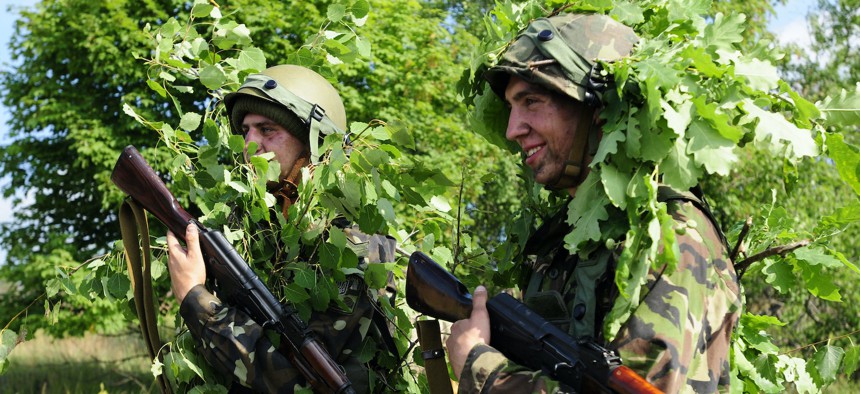
Ukrainian Soldiers prepare to ambush soldiers from the U.S., Ukraine, Romania and Bulgaria has they conduct reacting to contact training as part of their situational training at the multi-national exercise Rapid Trident 2015 at the International Peacekeeping and Security Center near Yavoriv, Ukraine, July 21, 2015. U.S. Army / Sgt. 1st Class Walter E. Van Ochten
US To Expand Ukraine Training Mission Early Next Year
New program aims to train 500 Ukrainians a month in Germany.
The United States military will expand its training program for Ukrainian forces to include joint maneuver and combined arms operations, as early as next month, Pentagon spokesman Brig. Gen. Pat Ryder said Thursday.
U.S. Army Europe and Africa Command’s Seventh Army Training Command will train the Ukrainian troops at ranges in Germany; about 500 Ukrainians a month are expected to go through the program. “It's essentially focused at the battalion level. And so as we move forward, we will stay flexible and adaptable based on the needs of our Ukrainian partners and the evolving situation in Ukraine,” Ryder said.
The U.S. has trained Ukrainian troops, including Special Operations Forces, since 2014. That training, which took place in the western part of Ukraine, was interrupted in February when Russia invaded. However, training of Ukrainian forces continued in other parts of Europe.
U.S. training in particular has been instrumental in helping Ukraine develop a strong non-commissioned officer corps. That has enabled the Ukrainian military to delegate much more battlefield authority down to lower level commanders—in contrast with Russia’s top-heavy approach—which helped Ukraine out-maneuver Russian forces on the battlefield in several key locations.
The expanded training “will also include battalion headquarters staff training,” Ryder said. “So the way to think about this is, as you show up for your training, first you're doing the classroom exercises to better understand what it is that you're going to learn, right? It's going to be a crawl, walk, run, and then you're going to shift to the practical application, starting from the squad platoon to the battalion level of applying these concepts, culminating in a field exercise where you're getting into more advanced training scenarios, how to respond to situations.”
The move reflects the U.S. decision to provide Ukraine with more and different types of weapons, requiring new training. It also shows that the United States believes Russia will continue to pose a threat to Ukraine for the foreseeable future, even if Ukrainian counter offenses are successful.
Ryder said the Pentagon does not anticipate having to send additional troops to Europe to handle the new training mission. And he acknowledged that for Ukrainians, taking advantage of the new training opportunity is not without tradeoffs. “It's a significant lift to take forces out of Ukraine to come to Germany or elsewhere to conduct that training, because any trooper that's not on the ground in Ukraine is a trooper that's not in the middle of the fight.”




